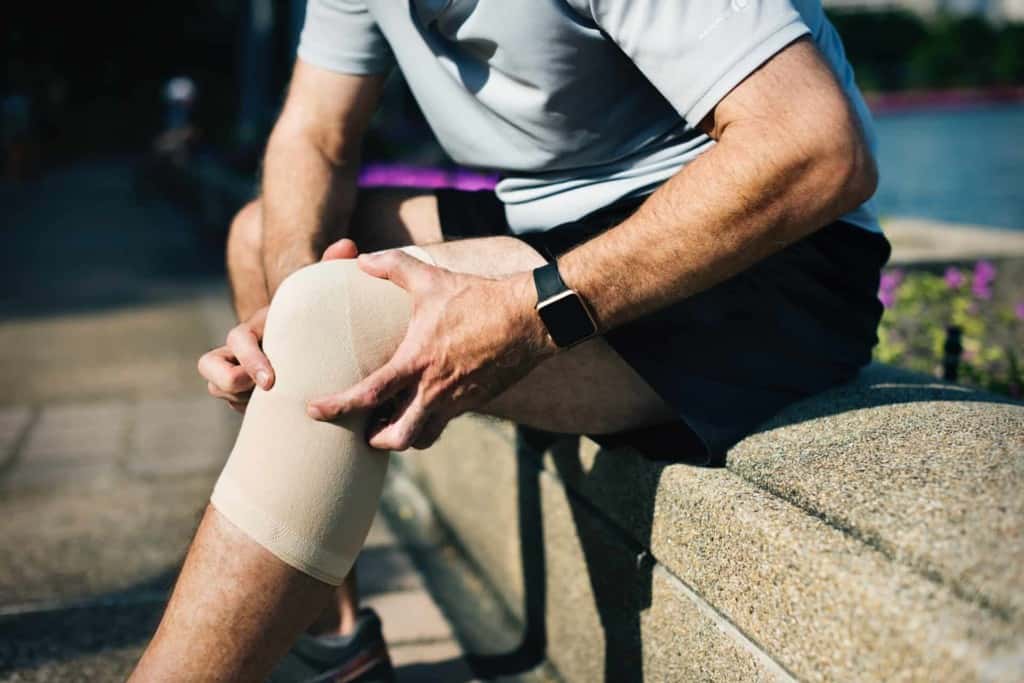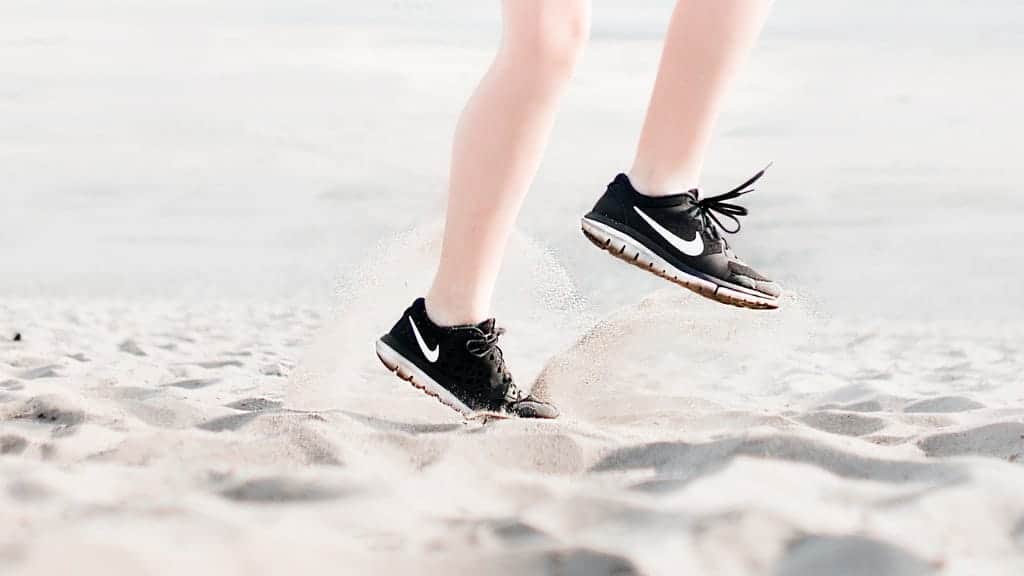If you want to relieve knee pain, there are a lot of things you can do. Everything from exercise and weight loss, to monitoring your diet, all of these have noticeable effects on the long term health of your knees and help relieve knee pain.
Keep in mind, this list of home remedies cannot fix a major medical emergency. If you have torn a tendon and experienced significant trauma to the muscle or cartilage in your knee, you need to seek out the help of a medical professional.
For all other chronic problems, consider these 12 home remedies for your knee pain.
Exercise
Regular exercise is a proven method for both prevention of chronic pain and alleviating already existing chronic pain with such conditions as osteoarthritis. (1)
Exercise prevents and helps chronic knee pain through strengthening the muscles surrounding the knee and improving the health of cartilage underneath the knee cap. As the muscles around the knee are strengthened, the knee is stabilized and the knee cap itself is able to track properly through the patella. Furthermore, exercise forces out excessive fluid buildup around the joint. This helps with joint stiffness and swelling. Consider the following common causes of knee pain and how exercise mitigates those problems:
– Unstable knee joint – mitigated through strengthening the surrounding muscle.
– Knee cap tracking improperly through the patella – mitigated through strengthening the surrounding muscle.
– Worn cartilage underneath the knee cap – mitigated as blood circulates through the joint and pumps settled fluid out.
A regular exercise routine is one of the best things you can do for the health of your knees.
Posture
Believe it or not, the way you sit in your chair makes a difference in the health of your knees. The three most common leg positions to avoid when sitting are the following:
– Legs pulled back underneath the chair.
– Sitting with your legs crossed.
– Sitting on your feet.
It is best to sit with your legs stretched out in front of you, with your knee caps unlocked.
Weight Loss
Obesity is a major predictor of chronic pain. Subsequently, research has demonstrated a credible weight loss program will improve knee health and offset chronic pain. Less weight on your knees will lead to a reduction in tension on the knee joint.
In a study conducted out of North Carolina, it was found that a loss of even 5% of body weight in obese adults experiencing chronic pain led to less pain. The recommended amount of weight loss, from the study, was 10%. (3)
Eat healthy food
Any pain in the body, especially pain in the knees, is caused by inflammation. Certain foods cause inflammation, while other foods are anti-inflammatory in nature. Therefore, you should avoid excessive amounts of inflammatory foods and consume anti-inflammatory foods. (4)
Inflammatory foods to avoid include:
– Added sugars in processed foods.
– Refined grains, such as white rice and white bread.
– Fatty acids.
– High fat red meats, such as beef.
Anti-inflammatory foods to consume:
– Fruits.
– Vegetables.
– Unsaturated fats.
– Fish.
– Low fat meats, such as chicken.
Adjusting your diet to whole foods will not only bring these anti-inflammatory benefits to your knees, but it will help in losing weight.
Medication
There are several over-the-counter medicines you can take to relieve pain in your knees. Note, however, that medication is NOT a fix for chronic pain. Medicine temporarily alleviates symptoms, rather than fixing the root cause of the problem.
The common medicines to take are Tylenol, Aspirin, Ibuprofen, and Naproxen. The differences between the drugs are slight, usually on the basis of overall strength of effect, but they all do the same basic thing. They all reduce inflammation.
If you are not a fan of taking oral medication, then capsaicin cream can help. Capsaicin cream works differently than other medications in that it blocks the chemical that sends pain messages to your brain, rather than reduces inflammation.
Massage
Massage therapy on the knee, particularly on the quadriceps muscles, has proven effective in improving the health of the knee. (5)
You can perform massage therapy on yourself at home. Simply take the heel of your hand, place it on the base of the quadriceps muscle (the group of muscles located around the top of the knee cap), and rock it back-and-forth while applying pressure. Be sure to thoroughly massage the inside and outside portions of the quadriceps muscles.
Natural Oils
The use of natural oils, also known as aromatherapy, reduces inflammation, stiffness, and pain. It does not fix the underlying causes of the inflammation or pain, but it does provide relieve knee pain. (6)
The following is a list of the natural oils to use for treating knee pain.
– Eucalyptus
– Frankincense
– Lavender
– Evening Primrose
– Ginger
– Turmeric
– Basil
All of these natural oils contain anti-inflammatory characteristics. As you apply the natural oil around your knee joint, the oil is absorbed into the skin and the affected muscles and tendons. A reduction in swelling around the knee will alleviate the stiffness and improve mobility temporarily.
RICE Method
If you are unfamiliar with the acronym, RICE, it stands for: Rest, Ice, Compression, Elevation.
The RICE method is one of the oldest methods of treating any type of injury. If your pain is the result of a sport-related injury, then RICE is where you should start. (7)
Rest allows the injured tendons, ligaments, and muscles surrounding your knee to recover. Ice freezes the muscle and tendons, which stops inflammation. Compression and elevation restrict excessive blood flow to the area temporarily, which would exaggerate pain symptoms.
Heat and Cold
Heat and cold are applied at different times to treat knee pain. It changes according to whether your pain is chronic or a temporary injury, and how far along you are in the recovery process.
If treating knee pain from an injury, cold should be applied immediately after the incident. Cold will stop the process of inflammation, providing a buffer for tendon and muscle recovery. Heat should be applied a couple of days after the initial injury, to allow blood to provide the needed nutrients for a speedy recovery.
When treating chronic pain, it is best to ice directly before and directly after physical activity. This will reduce inflammation, which will improve flexibility and improve mobility.
If you are in the process of exercising to improve chronic pain, then applying heat to the area around your knee a few hours after the workout, to speed the recovery process from your workout, may help.
Compression Sleeves / Brace
Compression sleeves and knee braces serve different functions. These devices apply light pressure around the joint to trap in body heat. Essentially, a compression sleeve is like strapping a low-grade heater onto your leg.
A knee brace applies pressure to the knee to provide stability to the joint and additional support to the muscles and tendons.
A compression sleeve should be worn for a few hours during the day, to provide heat therapy to the knee, which may prove beneficial in relieving knee pain.
A knee brace should be worn during physical activity, particularly in the event of a sport related injury. It will provide additional support to the injured muscle or tendon, while also taking primary responsibility for stabilizing the knee itself.
Stretch
Stretching and rolling has long been a great method for alleviating pain for tired, achy muscles, which may affect the health of your knees. However, there is a proper method of stretching that should be adhered to.
Avoid cold stretching. Cold stretching is attempting static stretches before warming a muscle up. Cold stretching forces the elongation of muscle fiber, rather than opening the muscle up for increased blood flow.
Use an active stretch warm up. An active stretching warm up would be lunges or sitting in the bottom of the squat position.
After an active warm up, dive into a round of static stretches.
Tai Chi
Tai Chi is a form of Chinese meditation that combines meditation with slow continuous movements.
A study conducted in Boston found that Tai Chi has all the benefits of physical therapy, with a few additional improvements over physical therapy. Whereas physical therapy had shown a significant reduction in chronic pain for roughly one-year, Tai Chi demonstrated continued to progress beyond a single year. Furthermore, participants in Tai Chi experienced reduction in other things such as depression and anxiety.
If you lack the time or money to enroll in a lengthy physical therapy treatment process, Tai Chi may prove a suitable alternative.
















